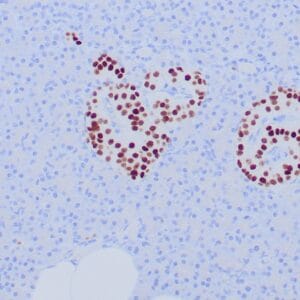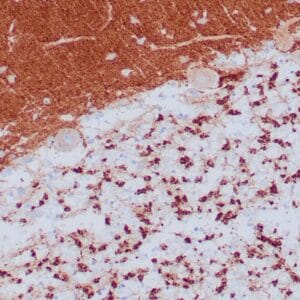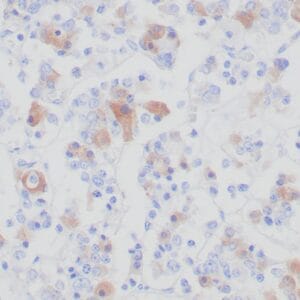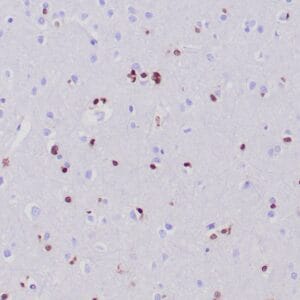| Weight | 1 lbs |
|---|---|
| Dimensions | 9 × 5 × 2 in |
| host | mouse |
| isotype | IgG |
| clonality | monoclonal |
| concentration | concentrate, predilute |
| applications | IHC |
| reactivity | human |
| available size | 0.1 mL, 0.5 mL, 1 mL concentrated, 7 mL prediluted |
rabbit anti-Somatostatin Receptor Type 2 (SSTR2) monoclonal antibody (ZR233) 6364
Price range: $160.00 through $528.00
Antibody summary
- Rabbit monoclonal to Somatostatin Receptor Type 2 (SSTR2)
- Suitable for: Immunohistochemistry (formalin-fixed, paraffin-embedded tissues)
- Reacts with: Human
- Isotype:IgG
- Control: Neuroendocrine tumor
- Visualization: cell surface
- 0.1, 0.5, 1.0 mL concentrated, 7 mL prediluted
rabbit anti-Somatostatin Receptor Type 2 (SSTR2) monoclonal antibody ZR233 6364
| target relevance |
|---|
| Protein names Somatostatin receptor type 2 (SS-2-R) (SS2-R) (SS2R) (SST2) (SRIF-1) |
| Gene names SSTR2,SSTR2 |
| Protein family G-protein coupled receptor 1 family |
| Mass 41333Da |
| Function FUNCTION: Receptor for somatostatin-14 and -28. This receptor is coupled via pertussis toxin sensitive G proteins to inhibition of adenylyl cyclase. In addition it stimulates phosphotyrosine phosphatase and PLC via pertussis toxin insensitive as well as sensitive G proteins. Inhibits calcium entry by suppressing voltage-dependent calcium channels. Acts as the functionally dominant somatostatin receptor in pancreatic alpha- and beta-cells where it mediates the inhibitory effect of somatostatin-14 on hormone secretion. Inhibits cell growth through enhancement of MAPK1 and MAPK2 phosphorylation and subsequent up-regulation of CDKN1B. Stimulates neuronal migration and axon outgrowth and may participate in neuron development and maturation during brain development. Mediates negative regulation of insulin receptor signaling through PTPN6. Inactivates SSTR3 receptor function following heterodimerization. {ECO:0000269|PubMed:15231824, ECO:0000269|PubMed:18653781, ECO:0000269|PubMed:19434240, ECO:0000269|PubMed:22495673, ECO:0000269|PubMed:22932785}. |
| Subellular location SUBCELLULAR LOCATION: Cell membrane; Multi-pass membrane protein. Cytoplasm. Note=Located mainly at the cell surface under basal conditions. Agonist stimulation results in internalization to the cytoplasm. |
| Tissues TISSUE SPECIFICITY: Expressed in both pancreatic alpha- and beta-cells (at protein level). Expressed at higher levels in the pancreas than other somatostatin receptors. Also expressed in the cerebrum and kidney and, in lesser amounts, in the jejunum, colon and liver. In the developing nervous system, expressed in the cortex where it is located in the preplate at early stages and is enriched in the outer part of the germinal zone at later stages. In the cerebellum, expressed in the deep part of the external granular layer at gestational week 19. This pattern persists until birth but disappears at adulthood. {ECO:0000269|PubMed:19434240, ECO:0000269|PubMed:22932785}. |
| Structure SUBUNIT: Homodimer and heterodimer with SSTR3 and SSTR5. Heterodimerization with SSTR3 inactivates SSTR3 receptor function. Heterodimerization with SSTR5 is enhanced by agonist stimulation of SSTR2 and increases SSTR2 cell growth inhibition activity. Following agonist stimulation, homodimers dissociate into monomers which is required for receptor internalization. Interacts with beta-arrestin; this interaction is necessary for receptor internalization and is destabilized by heterodimerization with SSTR5 which results in increased recycling of SSTR2 to the cell surface. Interacts (via C-terminus) with SHANK1 (via PDZ domain). {ECO:0000269|PubMed:10551867, ECO:0000269|PubMed:15231824, ECO:0000269|PubMed:18653781}. |
| Post-translational modification PTM: Phosphorylated on serine and threonine residues in response to agonist stimulation, leading to receptor desensitization and rapid internalization. Phosphorylated to a greater extent on serine than threonine residues. Threonine phosphorylation is required for arrestin binding and receptor endocytosis but is not necessary for desensitization (By similarity). {ECO:0000250}. |
| Target Relevance information above includes information from UniProt accession: P30874 |
| The UniProt Consortium |
Data
 |
| Formalin-fixed, paraffin-embedded human neuroendocrine tumor stained with anti-SSTR2 antibody using peroxidase-conjugate and DAB chromogen. Note cytoplasmic staining of tumor cells |
Publications
| pmid | title | authors | citation |
|---|---|---|---|
| We haven't added any publications to our database yet. | |||
Protocols
| relevant to this product |
|---|
| IHC |
Documents
| # | SDS | Certificate | |
|---|---|---|---|
| Please enter your product and batch number here to retrieve product datasheet, SDS, and QC information. | |||
Only logged in customers who have purchased this product may leave a review.















Reviews
There are no reviews yet.